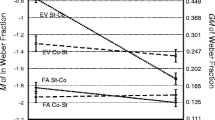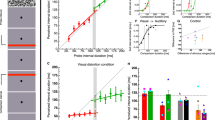Abstract
THE duration of the foreperiod, that is, the interval between some warning signal and the stimulus, has long since been known as one of the main factors which influence the length of simple reaction time2–4. Klemmer1 has recently shown that reaction time is shorter with brief (0.25 sec.) constant foreperiods than with either longer constant foreperiods or variable ones. He suggested that the critical factor is ‘time uncertainty’, that is, uncertainty as to the moment of occurrence of the stimulus. This uncertainty would result from the length of the foreperiod as well as from its objective variability, due to the inaccuracy of internal time estimation processes. Speed of reaction clearly depends on the possibility for some transitory state of preparation to be reached at the right time.
Similar content being viewed by others
References
Klemmer, E. T., J. Exp. Psychol., 51, 179 (1956).
Woodrow, H., Psychol. Monogr., 17 (5) (1914).
Woodworth, R. S., and Schlosberg, H., “Experimental Psychology” (Holt, New York, 1954).
Wundt, W., “Eléments de Psychologie physiologique” (Alcan, Paris, 1886).
Author information
Authors and Affiliations
Rights and permissions
About this article
Cite this article
BERTELSON, P., BOONS, JP. Time Uncertainty and Choice Reaction Time. Nature 187, 531–532 (1960). https://doi.org/10.1038/187531a0
Issue Date:
DOI: https://doi.org/10.1038/187531a0
- Springer Nature Limited
This article is cited by
-
The effect of temporal expectation on the correlations of frontal neural activity with alpha oscillation and sensory-motor latency
Scientific Reports (2023)
-
Behavioral and neural correlates of normal aging effects on motor preparatory mechanisms of speech production and limb movement
Experimental Brain Research (2019)
-
Effects of aging on temporal predictive mechanisms of speech and hand motor reaction time
Aging Clinical and Experimental Research (2018)
-
Fragile temporal prediction in patients with schizophrenia is related to minimal self disorders
Scientific Reports (2017)
-
Premotor neural correlates of predictive motor timing for speech production and hand movement: evidence for a temporal predictive code in the motor system
Experimental Brain Research (2017)





